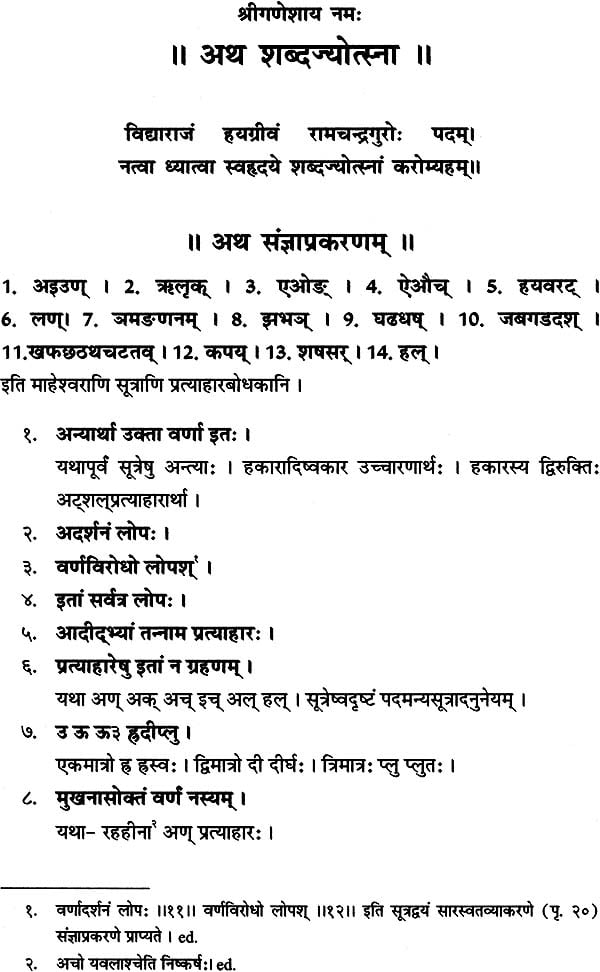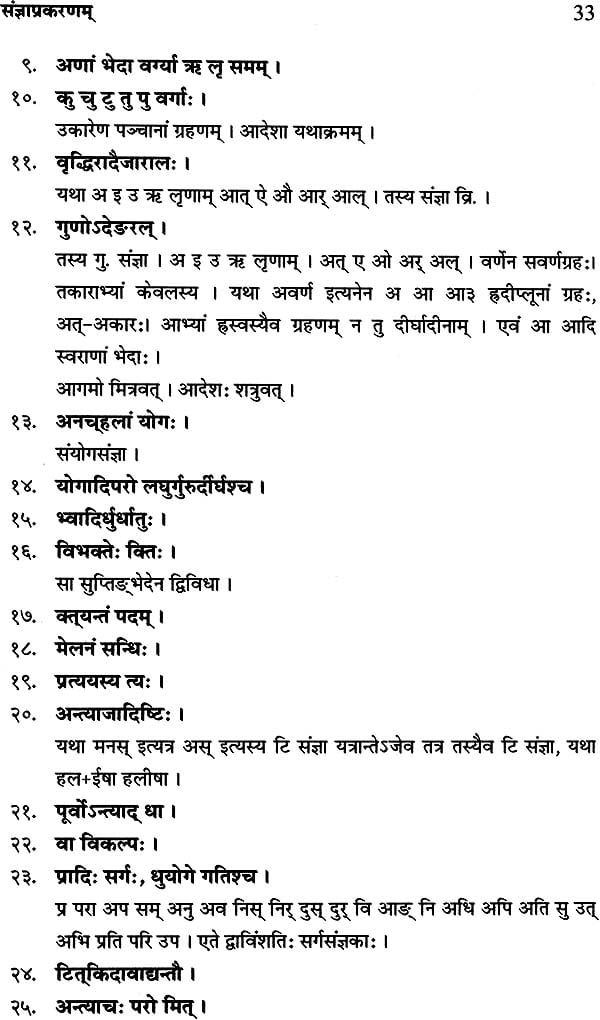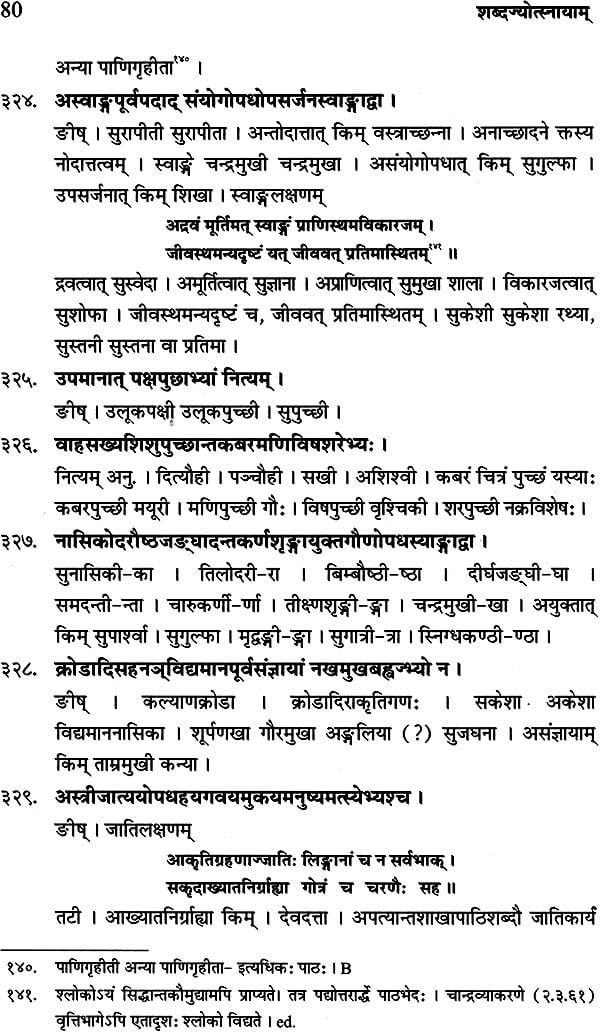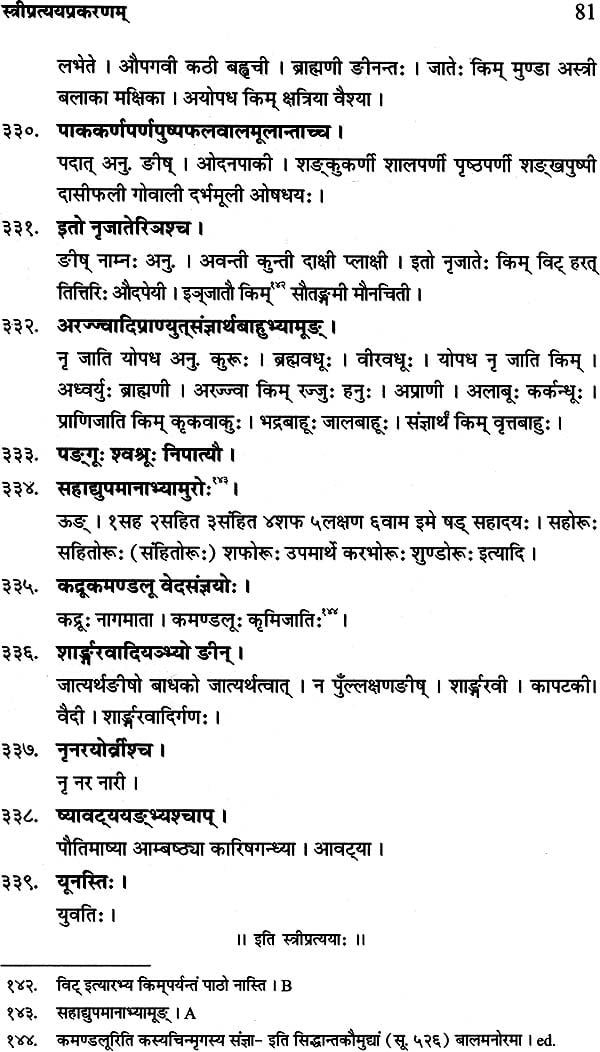
The Sabdajyotsna of Pandit Bhiksharam (A New Sanskrit Grammar)
Book Specification
| Item Code: | NAF334 |
| Author: | Shri Krishna Sharma |
| Publisher: | D. K. Printworld Pvt. Ltd. |
| Language: | Sanskrit Text with English Translation |
| Edition: | 2013 |
| ISBN: | 9788124606629 |
| Pages: | 127 |
| Cover: | Hardcover |
| Other Details | 9.0 Inch x 6.0 Inch |
| Weight | 340 gm |
Book Description
Pt. Bihiksharam (1887-1975) composed the Sabdajyotsna with a view to teach Sanskrit grammar to an ordinary student in a simple style. The author adopts pratyahara, anuvrtti, anubandha, etc. in his work to impart the abridgement on the pattern of Astadhyayi and Pratiskhyas. For this pupose, the author tries his best to simplify the tough process of learning Sanskrit grammar.
The sutras of the Sabdajyotsna are composed subject wise (according to Prakarana) on the pattern of prakriya works. Only samjna and sandhi prakarnas of this work were published in 1958. The rest of the text in Devanagari remained in the form of manuscript lying unattended. The script, whatever traced, was made available to Prof. Shri Krishan Sharma for the editing purpose by his grandson. However, the samasa prakarana and some portions of taddhita prakarana still remain untraceable.
In spite of some minor gaps, the work deserves recognition and appreciation in the academic circle. The author of the sabdajyotsna aimed at and indeed succeeded in fully exposing the rules of Sanskrit grammar in lucid and clear diction.
The work, a pioneering attempt of its kind, may very well be considered as a significant contribution of the tradition f Sanskrit grammar, benefiting students, teachers and researchers alike.
Dr. Shri Krishan Sharma, born in 1954, is a dedicated Professor of Indology in Kurukshetra University with vast experience in teaching and intensive research on various branches of Indological studies. He is a perfect blend of traditional Sastra learning and modern university education.
He has written/edited/compiled sixteen titles on different branches of Indic studies. His major work, the critical edition of the Aksaratantra, one of the Pratiskhya of samaveda, has brought approbation from Vedic scholars. Besides, he has written forty research papers in forty research papers in Sanskrit, Hindi and English, related to various aspects of Indology for well-reputed journals, felicitation and commemoration volumes, and proceedings of 14th world Sanskrit conference, Japan. He has visited Finland, Thailand, Scotland, Indonesia and Japan to present various research papers in World Sanskrit Conferences and other international conferences.
Under Dr Sharma’s supervision, sixteen research scholars have obtained PhD and twelve MPhil students have submitted their dissertations.
He was honoured by Jawaharlal Nehru Memorial Fund, New Delhi, in recognition of his academic achievement and received the Bana Bhatta Award (2009) from Haryana Sanskrit Academy.
It gives me a genuine satisfaction that Dr Shri Krishan Sharma, Professor, Institute of Sanskrit & Indological Studies, Kurukshetra has done the commendable work of editing a rare treatise the Sabdajyotsna, a new Sanskrit Grammar composed by Pt Bhiksharam of village Barana (kurukshetra) during 1942-45.
In order to promote intensive research in Sanskrit and Indology in the state of Haryana, on the eve of Silver Jubilee of Kurukshetra University, the Institute of Sanskrit & Indological studies was established on the campus of this university. The foremost aim of this institute has also been to edit and publish rare treatises procured in the form of manuscripts. On the holy land of Kurukshetra, the publication of such manuscript of the Sabdajyotsna a scholarly grammar can be taken as an important step to fulfill the aim of the institute.
I congratulate Dr. Sharma for getting this work published. I hope, the publication of this treatise will bring forth the glorious cultural heritage and Sastric tradition of Kurukshetra as well as of Haryana to the scholars of Sanskrit.
The publication of the Sabdajyotsna has been a long desideratum since August 1985. Rameshwar Dutt Sharma of Bhiwani (Haryana) exhibited some manuscripts of the Sabdajyotsna along with it s printed portion up to Sandhi chapter before the participants in the All-Indian Seminar on Manuscriptology, organized under joint auspices of the Institute of Sanskrit & Indological studies and Department of Sanskrit in Kurukshetra Uninversity on 16-19 August 1985. At that time, Sharma entrusted the publication of this important treatise to me.
I considered myself fortunate and honoured to have this assignment of my interest. I tried my best to collect all manuscripts from the native place of the author, i.e. village of Barana near Kurukshetra. Four manuscripts were procured from the house of Hira Lal Parashar, grandson of Pt Bhiksharan. All of three manuscripts where incomplete and only one of them was having beginning and end and that too with the missing samasa chapter and starting portion of the taddhita. Besides, much time was lost in trying to recover these missing portions. The inordinate delay in the publication of this work was very painful to me, while the family members of the author were very keenly interested to have the book published soon.
During this period, I used to make a collation of the manuscripts along with a critical study. As a result, a research paper on the critical introduction to the sabdajyotsma was presented in the Indian Linguistics section of the 35th Session of the All India Oriental Conference held at Hardwar on 16-18 November 1990. In making the assessment of this treatise, scholars insisted that I should bring out a critical edition of this work.
Sureendra Kumar, Research Scholar, submitted his thesis for Ph.D. degree of Kurukshetra University in June 2008 under my supervision, which was based on only one MS. of the Sabdajyotsna. The examiner of the thesis Ved Kumari Ghai and eminent grammarian encouraged me to edit this treatise critically on the basis of critical apparatus available.
The learning and teaching of Sanskrit grammar have been a continuous practice flowing down since very early times. Patanjali, in his Mahabhasya, interprets at least five rcas as having philosophical and phonetical thought inherent in them. So, it is clear that grammatical studies had been founded before the period of samhitas. Analysis of prakrti, pratyaya, dhatu upsarga and various components of compound words in the padapatha of vedic mantras shows a refined stage of grammatical practice. The term vyakarana for science of words is found used in Brahmanas, upanisads, the Ramayana the Mahabharata etc.
According to the Sanskrit works of Paninian school, Brahma Brhaspati and other sages like bharadvaja composed their grammars in their peculiar styles. Sakatayana and scholars like Gargya presented an interesting discussion on the relation of word and root. Panini quotes ten grammarians in the Astadhyayi as a token of regard. Pt yudhisthira Minamsaka (1984: 126-27) also has presented a list of sixty four scholars quoted in pre-panini ancient literature, which is sufficient to show the active interest taken by ancient scholars in grammatical subjects.
After a deep study of previous works, Panini composed his Sanskrit grammar, which stands like a beacon. In the light of this work, all other works were obscure and faintly visible. But the practice of Sanskrit grammar remained in continuous process or tradition and after Panini about twenty works on Sanskrit grammar came to light.
In the same way, Pt Bhikasharam, a public and erudite scholar of Sanskrit grammar, composed his Sanskrit grammar named the sabdajyotsna, which can be taken as a new step in the same tradition.
| 1 | Foreword | vii |
| 2 | Opinions | ix |
| 3 | Preface | xi |
| 4 | The Critical Apparatus | xiii |
| 5 | Achnowledgements | xvii |
| 6 | List of Abbriviations | xxix |
| 7 | Introduction | 1 |
| 8 | Genealogy of Pt Bhiksharam | 27 |
| 9 | List of Sutras | 89 |
| 10 | Bibliography | 96 |
| 11 | Colophon of the Sabdajyotsna | 98 |









